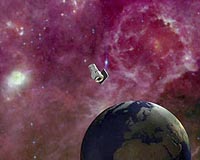|
|
|
NASA's Wise Gets Ready To Survey Whole Sky Pasadena CA (SPX) Nov 18, 2009  NASA's Wide-field Infrared Survey Explorer, or Wise, is chilled out, sporting a sunshade and getting ready to roll. NASA's newest spacecraft is scheduled to roll to the pad on Friday, Nov. 20, its last stop before launching into space to survey the entire sky in infrared light. Wise is scheduled to launch no earlier than 6:09 a.m. PST (9:09 a.m. EST) on Dec. 9 from Vandenberg Air Force ... read more
NASA's Wide-field Infrared Survey Explorer, or Wise, is chilled out, sporting a sunshade and getting ready to roll. NASA's newest spacecraft is scheduled to roll to the pad on Friday, Nov. 20, its last stop before launching into space to survey the entire sky in infrared light. Wise is scheduled to launch no earlier than 6:09 a.m. PST (9:09 a.m. EST) on Dec. 9 from Vandenberg Air Force ... read moreRecord-Breaking Radio Astronomy Experiment  Washington DC (SPX) Nov 18, 2009
Washington DC (SPX) Nov 18, 2009Astronomers will tie together the largest collection of the world's radio telescopes ever assembled to work as a single observing tool in a project aimed at improving the precision of the reference frame scientists use to measure positions in the sky. The National Science Foundation's Very Long Baseline Array (VLBA) will be a key part of the project. For 24 hours, starting Wednesday ... more
|
Vietnam says parched Red River at record low
China to be world's third biggest wind power producer: media Cost-cutting NASA eyes three cheap space missions Honduras declares state of emergency amid drought Russia in secret plan to save Earth from asteroid: official Sarkozy scrambles to salvage carbon tax French carbon tax ruled illegal Brazil's Lula signs law cutting CO2 emissions 2009 a 'benign' year of natural disasters: German re-insurer Greenpeace Spain demands Denmark release its director
| |||||||||||||||
| Previous Issues | Nov 17 | Nov 16 | Nov 13 | Nov 12 | Nov 11 |
| . |
Exoplanets Clue To Sun's Curious Chemistry Paris, France (SPX) Nov 18, 2009
Paris, France (SPX) Nov 18, 2009A ground-breaking census of 500 stars, 70 of which are known to host planets, has successfully linked the long-standing "lithium mystery" observed in the Sun to the presence of planetary systems. Using ESO's successful HARPS spectrograph, a team of astronomers has found that Sun-like stars that host planets have destroyed their lithium much more efficiently than "planet-free" stars. ... more Ghostly 'Spokes' Puff Out From Saturn's Ring's  Pasadena CA (SPX) Nov 17, 2009
Pasadena CA (SPX) Nov 17, 2009Massive, bright clouds of tiny ice particles hover above the darkened rings of Saturn in an image captured by the Cassini spacecraft on Sept. 22, 2009, around the time of Saturn's equinox. During this period, sunlight hits the rings edge-on and shines directly over the equator. The levitating icy particle clouds, which are known as "spokes" and are as wide as 10,000 kilometers ... more Discovery Of A Retrograde Or Highly Tilted Exoplanet  Tokyo, Japan (SPX) Nov 18, 2009
Tokyo, Japan (SPX) Nov 18, 2009Two teams of astronomers have found that extrasolar planet HAT-P-7b, discovered in 2008, has a retrograde or highly tilted orbit. On UT May 30, 2009, a Japanese collaboration team led by Norio Narita (National Astronomical Observatory of Japan) used the Subaru Telescope's High Dispersion Spectrograph (HDS) to observe the HAT-P-7 planetary system, which is about 1000 light-years distant from Eart ... more |
. |
| . |
New Report Offers Steps To Outer Space Security Paris, FRance (SPX) Nov 16, 2009
Paris, FRance (SPX) Nov 16, 2009Outer space security has become an increasingly important issue over recent years. For example, the global community of spacefaring nations is witnessing a sizeable increase in orbital debris from both deliberate and accidental satellite destructions. A new report has flagged a series of recommendations to help address the orbital debris concern, and other issues that can assure enhanced ... more Dawn Enters Asteroid Belt -- For Good  Pasadena CA (SPX) Nov 16, 2009
Pasadena CA (SPX) Nov 16, 2009NASA's Dawn spacecraft re-entered our solar system's asteroid belt on Nov. 13, and this time it will stay there. Dawn first entered the belt (whose lower boundary may be defined as the greatest distance Mars gets from the sun (249,230,000 kilometers, or 154,864,000 miles) in June 2008. It remained within the belt for 40 days before its carefully planned orbital path brought it below the ... more New Moon Sets Stage For Brilliant Leonids Meteor Shower  Greenbelt MD (SPX) Nov 16, 2009
Greenbelt MD (SPX) Nov 16, 2009This year's Leonids meteor shower peaks on Tuesday, Nov. 17. If forecasters are correct, the shower should produce a mild but pretty sprinkling of meteors over North America followed by a more intense outburst over Asia. The phase of the moon will be new -- setting the stage for what could be one of the best Leonid showers in years. "We're predicting 20 to 30 meteors per hour over ... more |
. |
| Previous Issues | Nov 17 | Nov 16 | Nov 13 | Nov 12 | Nov 11 |
| The contents herein, unless otherwise known to be public domain, are Copyright 1995-2009 - SpaceDaily. AFP and UPI Wire Stories are copyright Agence France-Presse and United Press International. ESA Portal Reports are copyright European Space Agency. All NASA sourced material is public domain. Additional copyrights may apply in whole or part to other bona fide parties. Advertising does not imply endorsement, agreement or approval of any opinions, statements or information provided by SpaceDaily on any web page published or hosted by SpaceDaily. Privacy statement |